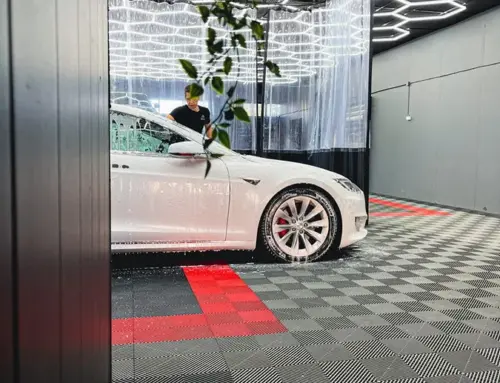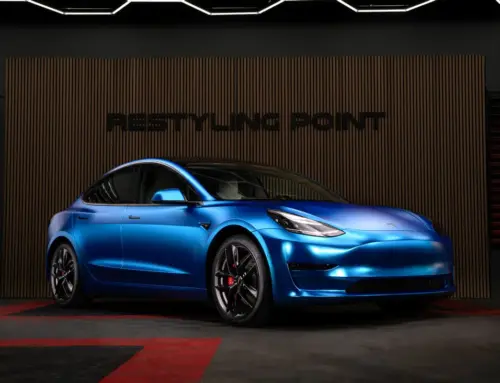Did you buy a new car and are unsure which product to trust? Which one is the right choice for your criteria? Which one truly protects against scratches, which one is worth your money?
The original honest reason for comparing ceramic coating and PPF film is the deliberate falsification of their properties and adding the best technical characteristics to the product it doesn’t belong to.
Often the differences between PPF film and ceramic coating are confused, and their essential technical differences are overlooked. Both have their own strong advantages, but there are also weaknesses. These are not always publicly disclosed, and often the information for both is varied on Google.
What is ceramic coating?
Ceramic coating emerged in the category of chemicals after waxes and light coatings, sending the aforementioned into history due to its excellent durability, ceramic coating gained popularity.
Ceramic coating is a liquid mixture of several chemical compounds formulated in the laboratory, which is applied to the surface of the car’s paint, and once dried, it forms a chemical protection that cannot be washed off. So, it’s a liquid that dries onto the car. Everyone has heard of waxes. This is an innovative version of wax. Waxes lasted a few months, ceramic coating lasts for years.
Protection against chemicals
Ceramic coating primarily provides chemical protection to the car’s paint. It protects against road salt, oils on the road, chemicals, and the most common types of dirt.
Prevention from UV radiation and oxidation
The harmful UV rays from the sun fade the paint, causing the color of the paint to lose its depth. There is also lime in the wash water, which, when dried on the paint surface, can leave spots that look like oxidation, similar to rare acid rain.
Enhanced gloss
High-quality ceramic coating enhances the depth of color and improves the gloss level of the car, making it mirror-like and helping to identify the car among others. A stunning gloss is a delight to the eye.

Easy Maintenance
Hydrophobicity, or water repellency, is one of the most notable characteristics of ceramic coating. The coating saves time in car maintenance and makes it maximally easy.
Dirt does not adhere to the ceramic coating as well as it does to unprotected paint surfaces. Thanks to the hydrophobic effect, the contact angle of the droplets left on the surface is high, making it easier for the droplets to run off the car’s surface. Consequently, dirt and sand flow away with the droplet. This reduces the formation of light washing scratches during car washing.

Prevention of Stone Chips and Scratches
Because ceramic coating is a liquid and, once cured, it creates a layer approximately 1-3 microns thick, unfortunately, it does not prevent deep scratches or stone chips. It does, however, prevent and reduce the formation of light washing scratches on the paint surface.
Many drivers have reported seeing claims in the automotive industry that ceramic coating prevents scratches. Distorting facts does not bring good reputation to the automotive industry, nor does it guarantee customer satisfaction.
Therefore, the claim that ceramic coating prevents scratches is as unrealistic as the Turkish national team winning against Finland in ice hockey.

What is PPF – Paint Protection Film?
PPF stands for Paint Protection Film, which is a protective film for paint. It is typically 180-300 microns thick transparent polyurethane film that provides both chemical and physical protection to the car’s paint surface.
It is designed to be applied to the paint surface to protect it while also serving as a secondary new surface that can withstand daily mechanical stresses.
Completely clear and properly installed, the film is entirely inconspicuous and falls into the category of traditional tapes, but it is significantly more durable due to its thickness. Overlapping tape is ~100μm thick, whereas PPF is ~200μm thick.

Chemical Protection
Since PPF is a film, it acts as a physical shield in front of the installed object. It repels all potential daily chemical damages, prevents them from reaching the paint surface, and maintains its brilliant appearance nonetheless.
Prevention of UV Radiation and Oxidation
UV radiation is merciless, but not for modern PPF films. In the past, UV radiation yellowed PPF films, and it still does, but only for low-quality films. Modern high-quality PPF films come with over 7 years of yellowing warranty.
The film also withstands oxidation excellently.
Enhanced Gloss
One of the characteristics of PPF film is the deep gloss it provides to its object. It also acts as a secondary clear coat, resulting in the underlying paint surface shining in its new brilliance. If the front end is protected with normal tape and the rest of the car is not, you won’t notice any difference in gloss.

Ease of Maintenance
On top of the PPF film is a TopCoat coating, which makes maintaining PPF clean and effortless. Water and dirt slide off, washing processes are faster. This feature is comparable to ceramic coating.
However, there are no scientific facts yet about the durability of TopCoat, but based on our experience, it lasts 1-2 years.
Prevention of Stone Chips and Scratches
PPF repels stone chips and scratches, preventing them from reaching the paint surface. Even the most common strong parking dents. The tape is thick and elastic enough, making it excellent at withstanding nails and strong scratches. For example, if a ballpoint pen is pressed into the skin, the skin’s elasticity allows it to return to its smooth state. PPF tape behaves in the same way. When a stone hits the middle of the hood, there is hardly any trace left.

Parking spaces are tight, and thanks to the PPF paint protection film, the most common parking dents can be avoided. This has been proven in the cars of dozens of customers.
The film also has an official Self-Healing feature. As the name suggests, the self-healing feature repairs light scratches on its own.
The Self-Healing feature is activated by heat, whether it comes from the sun, a hot air blower, or hot water. So, heat in any form activates the surface of the PPF film and sets the molecules in motion, causing the scratch to close up, just like a cut on our skin.
What does all this mean?
Ceramic coating only protects against UV radiation and fading. It prevents dirt from adhering heavily to the paint surface, makes cleaning easier, and prevents the formation of minor washing scratches. It brings shine and gives the car owner more aesthetic enjoyment when they see their car cleaner. The coating is more affordable.
PPF stone chip film does the same as ceramic coating for initial warming up, but in addition, it also protects against common stone chips and scratches. It is a protective film cast at the tape factory, which acts as a shield in front of the car’s paint surface and absorbs the stresses itself, preventing them from reaching the paint surface.
Thus, the liquid and installed tape cannot and should not compete in the same category, as they are two completely different products with different characteristics.
Can ceramic coating prevent scratches? Weakly.
Can PPF stone chip protection film prevent scratches and stone chips? Yes. 24/7 for up to 16 years.
Recently, a PPF film that had served a Lamborghini for 16 years was removed, and it could have served even longer. We were amazed at how well it had preserved and how the underlying paint surface was completely new and untouched. Not a single stone chip, not the slightest scratch on a 16-year-old car!
So, if maximum protection and resale value for the car are desired, then PPF paint protection film is the only product that adds value when properly installed.

Warranty terms and instructions
Warranty-wise, ceramic coating typically lasts on average between 3 to 7 years, while PPF protective film lasts 7 to 10+ years, depending on the manufacturer. Both require proper cleaning and maintenance intervals.
Sometimes you hear businesses promising unrealistic features. It’s good to maintain ceramic coatings at least once a year by going for maintenance washes. During these washes, the car is chemically cleaned, and an activating/reinforcing chemical mixture is applied to the paint, helping the coating endure and serve the customer better. In some coating brands, this is a mandatory step, in others it’s only recommended.
Regular maintenance washes are also advisable for PPF film, along with making necessary cuts and repairs to the film. Since the film acts as a shield in front of the paint, all stresses are directed only to the film, sometimes straining it. Also, improperly cleaned edges of the film may detach by a few millimeters, in which case it’s advisable to perform a repair procedure by a professional. Generally, there are no risks if the film detaches by a few millimeters from any point, because the adhesive keeps the film tightly attached to the remaining portion. Cuts are not recommended to be made by oneself under any circumstances, as this poses a significant risk of forming cuts on the paint.
A professional can apply a film piece to their own skin and perform a film cut without cutting the skin.
The worst combination for any of these products is to bring a dirty car into a warm garage in winter for storage. Also, irregular car washing and a low number of washes are detrimental. This causes the dirt on the car to harden onto the paint surface, and removing it can be extremely difficult. For example, certain types of dirt removal may be impossible on cars with matte PPF film or matte factory paint because certain types of dirt may only come off with machine polishing, and this process glosses the matte surface, which is an absolute no for matte finishes.
In summary, nothing is eternal, but when comparing ceramic coating and film, it’s advisable to rely on facts. Which one suits you?
Do you want the work to be done responsibly, on schedule, and with the best value for your money? Ask for a quote from the professionals at Restyling Point, who do this with quality standards, values, and love.
On WhatsApp: +358445050624
Phone: +358445050624
Email: [email protected]
Restyling Point Oy – The leading in Nordic countries in wrapping and protection treatments











